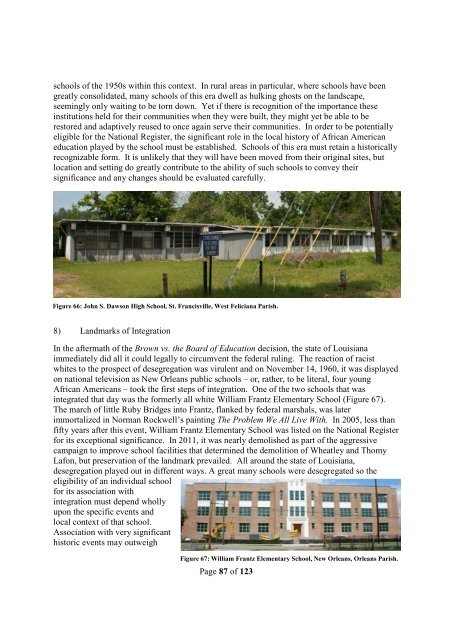The African American Experience in Louisiana
The_African_American_Experience_in_Louisiana
The_African_American_Experience_in_Louisiana
- No tags were found...
Create successful ePaper yourself
Turn your PDF publications into a flip-book with our unique Google optimized e-Paper software.
schools of the 1950s with<strong>in</strong> this context. In rural areas <strong>in</strong> particular, where schools have been<br />
greatly consolidated, many schools of this era dwell as hulk<strong>in</strong>g ghosts on the landscape,<br />
seem<strong>in</strong>gly only wait<strong>in</strong>g to be torn down. Yet if there is recognition of the importance these<br />
<strong>in</strong>stitutions held for their communities when they were built, they might yet be able to be<br />
restored and adaptively reused to once aga<strong>in</strong> serve their communities. In order to be potentially<br />
eligible for the National Register, the significant role <strong>in</strong> the local history of <strong>African</strong> <strong>American</strong><br />
education played by the school must be established. Schools of this era must reta<strong>in</strong> a historically<br />
recognizable form. It is unlikely that they will have been moved from their orig<strong>in</strong>al sites, but<br />
location and sett<strong>in</strong>g do greatly contribute to the ability of such schools to convey their<br />
significance and any changes should be evaluated carefully.<br />
Figure 66: John S. Dawson High School, St. Francisville, West Feliciana Parish.<br />
8) Landmarks of Integration<br />
In the aftermath of the Brown vs. the Board of Education decision, the state of <strong>Louisiana</strong><br />
immediately did all it could legally to circumvent the federal rul<strong>in</strong>g. <strong>The</strong> reaction of racist<br />
whites to the prospect of desegregation was virulent and on November 14, 1960, it was displayed<br />
on national television as New Orleans public schools – or, rather, to be literal, four young<br />
<strong>African</strong> <strong>American</strong>s – took the first steps of <strong>in</strong>tegration. One of the two schools that was<br />
<strong>in</strong>tegrated that day was the formerly all white William Frantz Elementary School (Figure 67).<br />
<strong>The</strong> march of little Ruby Bridges <strong>in</strong>to Frantz, flanked by federal marshals,<br />
was later<br />
immortalized <strong>in</strong> Norman Rockwell’s pa<strong>in</strong>t<strong>in</strong>g <strong>The</strong> Problem We All Live With. In 2005, less than<br />
fifty years after this event, William Frantz Elementary School was listed on the National Register<br />
for its exceptional significance. In 2011, it was nearly demolished as part of the aggressive<br />
campaign to improve school facilities that determ<strong>in</strong>ed the demolition of Wheatley and Thomy<br />
Lafon, but preservation of the landmark prevailed. All around the state of <strong>Louisiana</strong>,<br />
desegregation played out <strong>in</strong> different ways. A great many schools were desegregated so the<br />
eligibility of an <strong>in</strong>dividual school<br />
for its association with<br />
<strong>in</strong>tegration must depend wholly<br />
upon the specific events and<br />
local context of that school.<br />
Association with very significant<br />
historic events may outweigh<br />
Figure 67: William Frantz Elementary School, New Orleans, Orleans Parish.<br />
Page 87 of 123


